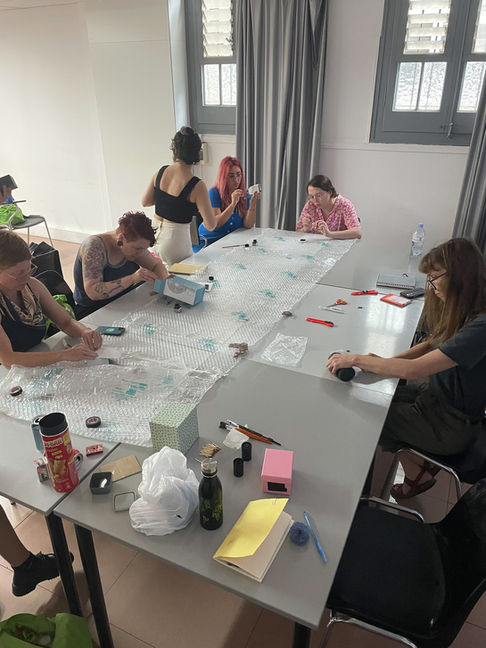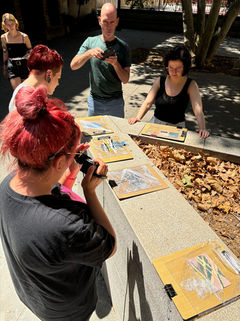From December 1 to December 31, 2023, we opened the call for applications to anyone interested in joining the International Residency of Experimentation IEFC-EXP 2024. The residency took place during the 10 days leading up to the Experimental Photo Festival, from July 13 to July 23, 2024.
During their stay, each resident had a day to conduct a theoretical-practical workshop where they explained an experimental technique to the rest of the group. The residency aimed to create a small, horizontal community of collaborative learning where eight different techniques were worked on, rather than a space where each participant worked individually on their personal projects. The residency concluded with a collective exhibition showcasing the learning process of the different techniques, rather than the results, which was displayed on the ground floor of the Institut d'Estudis Fotogràfics de Catalunya during the Experimental Photo Festival in Barcelona.
Directed and Coordinated
by Célica Véliz
Artists
Kit Martin - United Kingdom
Henri Blommers - Netherlands
Brenna Hansen - United States
Camila Nahien - Chile
Tanja Upravitelev - Germany
Millee Tibbs - United States
Karolina Gliniewicz - Poland-United Kingdom
Sofía Nercasseau - Chile

Workshops
Kit Martin - Cyanotype at the Sea Shore
In this workshop, we explored the process of cyanotype, an ancient photographic technique that used photosensitive emulsions to create blue prints. The unique aspect of this course was its relocation to a nearby beach, where the coast became our canvas. We took advantage of natural light and available organic elements to bring unique compositions to life. Participants selected objects found on the beach to creatively incorporate them into the process.


Henri Blommers - CyanoLumen
In this workshop, we delved into innovative methods to push the boundaries beyond traditional approaches to cyanotype and photograms. We used CianoLumen to experiment with various masking materials, creating intricate cutouts, layers of translucent materials, and different substances to achieve unique reactions. By combining these techniques, we discovered new dimensions in our images and developed a fresh visual vocabulary. In addition to cyanotype chemicals and masking materials, we incorporated household substances such as salt, fruit juices, vinegar, and more, encouraging participants to explore their creativity and adapt their approach to their chosen theme or subject.
Brenna Hansen - Finding. Collage with Lumen & Darkroom Photograms
In this workshop, participants embarked on an artistic exploration of photographic collage techniques. The workshop was divided into several components to provide practical experience and foster collaborative creativity. In the first part, we presented the conceptual framework supporting our creative initiative. Through theoretical discussion and historical context, we explored found images, collage techniques, and image overlay. Inspired by renowned artists and examples from my own work, we delved into how analog and alternative photographic processes reveal new messages in existing images. After the theoretical segment, participants carried out practical exercises to apply the discussed concepts.


Camila Nahien - Papel Salado: la Corrosión de la Memoria
We explored the technique of salted paper while collaborating on the creation of a collective fanzine filled with family images. In this workshop, we achieved several objectives. We began with theory, where we delved into the history and craftsmanship of salted paper, uncovering its secrets from its humble origins to modern chemical advancements. Then, we immersed ourselves in the selection and preparation of images. Each participant chose images evocative of family memories and we learned to prepare image matrices using salted paper in a practical session. With the images ready, we embarked on the composition of a collective fanzine, exploring design and layout techniques to create a final project that reflected our collaboration and joint creativity. This workshop was designed for all skill levels, from beginners to experienced practitioners.
Tanja Upravitelev - All Art In. X-Ray Pinhole Opportunities
The workshop covered the theory of pinhole photography, exploring its historical, physical, and chemical aspects. We examined optical phenomena with pinhole cameras to create a specific atmosphere in our photographs. We reviewed the work of contemporary artists such as Nuala Mahon, Marcia C. Sheer, and Markus Kaesler. In the practical part, participants built pinhole cameras, took photos on photographic paper, and developed negatives. Pinhole photography offered versatility, allowing the use of industrially sensitized paper or X-ray films for transparent negatives. These negatives were transformed into positive images using various techniques. We also experimented with caffenol, an economical and eco-friendly developer, and captured images through multiple pinholes.


Millee Tibbs - Exposure Masking. Merging Photograms & Photographs
This workshop focused on transforming selected negatives using the technique of masking through multiple exposures. Participants began by choosing a negative from their collection, setting the stage for their creative process. They created masks through drawing, cutting, and assembling with precision and attention to detail. These masks played a crucial role in the exposure process. Using the customized masks, participants applied them to the negatives during exposure to achieve their artistic vision. The exposed paper was processed with established techniques in the darkroom. During the workshop, participants had the opportunity to explore and experiment independently in the darkroom environment.
Karolina Gliniewicz - ASMR photography, ASMR videography, animation, collage, Sound recordings, MIDI controllers, video postproduction
We began with an explanation of intra-, multi-, cross-, inter-, and transdisciplinary approaches, breaking down their meaning and impact on artistic practice and the mediums used. I presented my artistic approach and my research projects on ASMR and AI. We explored objects that provoke intense sensations and discussed the concept of ASMR. Divided into groups, each created an ASMR recording setup. We explained techniques, made video and sound recordings, and experimented with MIDI controllers. Participants recorded freely and, finally, dedicated an hour to post-production and reflection.


Sofía Nercasseau - Copias por contacto -fotogramas caseros-
The workshop covered a review of analog photography throughout history, highlighting the technique of photograms and rayograms by Man Ray. The importance of the copy and the original was emphasized, as well as the basic principles of photography, including positive and negative. We explored the process of the Hectograph, an old photocopying technique that was used during the workshop. Additionally, we reviewed color imaging, focusing on the overlay of the three primary colors (trichromy). We constructed the inking of the matrix, selected and composed textures, and made copies as photograms. Participants learned to create copies of textures in three colors to generate a trichrome.
Exposición
Collective Exhibitions of Processes
International Residency of Experimentation EXP-IEFC
The residency seeks to generate a small horizontal community of collaborative learning, where each person, every day, teaches in a theoretical-practical workshop, an experimental technique and their way of working to their fellow residents, emphasizing the mixture of techniques, the message and collaborative work. This is a community where different processes can coexist and dialogue: from open-air cyanotype, salted paper and artisanal publications, pinhole photography and its multiple ramifications, photograms with ink, their combinations with collage and lumen print, traditional darkroom, ASMR photography associated with animation and post-production, as well as cyanolumens, taking the possibilities of the technique further. Having ten days to work, we did not want to make an exhibition of closed works or finished projects, we understand that this is a starting point for learning, research and collaboration. That is why what you are seeing here is an exhibition of work in progress, taking as reference Paul Valéry and his First Lecture of 1937 in which he proposed the term poïétique to refer to “the study, not of the completed work, but of its production and conditions of realization.”



























